
Most people have a dominant side, so when you squat or leg press, the stronger leg naturally takes the lead, says Michele Olson, PhD, professor of sport science at Huntingdon College. "The weaker leg will struggle harder to complete the same number of repetitions. So one-legged moves can go far to balance out the right and left sides of the lower body. They keep you honest."
Go easy in the beginning, starting with one set and gradually working your way up to three sets, Olson says. "Start your one-legged exercises on the weaker leg, and then work your stronger leg."
Video of the Day
Video of the Day
Benefits of Unilateral Exercises
In addition to balancing out both sides of the body, single-leg (unilateral) exercises work the deep lateral stabilizers of the hip and core (i.e., gluteus medius and quadratus lumborum) in ways we can't duplicate with bilateral moves, says Neal Pire, exercise physiologist at HNH Fitness.
"There's also more carryover to normal ground-based movements like walking, skipping and running than you have with bilateral exercise." Try adding a few of the following exercises into your regular weight-training regimen for better balance and greater strength.
Step-Up
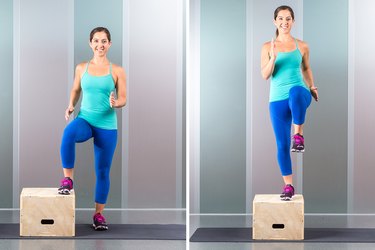
- Stand with a 12- to 18-inch plyo box or bench at your right side, right foot on the box.
- Straighten your right leg to stand up on the box.
- Root through your right heel and raise your left knee until both your left hip and knee reach 90 degrees.
- Step down with the left leg, bending the hip and knee of the right leg.
Reps: 10 to 15 on each side
Targets: glutes, hamstrings and quadriceps
Bulgarian Split Squat
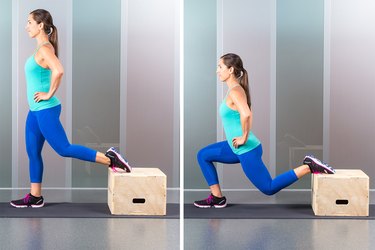
This one-legged squat resembles a lunge, except the non-working leg is propped up on a bench for balance.
- Stand two to three feet in front of a bench, back to the bench.
- Reach one foot back so that your toes rest on the bench, other foot planted in front.
- Keep your head up, back straight and chest out as you bend your knees and lower your back knee until your front thigh is parallel to the floor.
- Exhale and stand back up.
Reps: 10 to 15 on each side
Targets: quadriceps and glutes
Single-Leg Glute Bridge
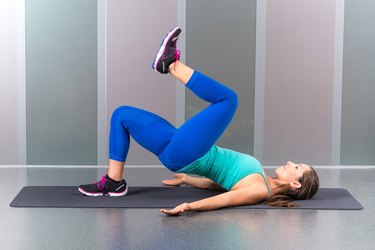
- Lie on the floor with your feet flat, knees bent. You can also put your feet on a bench.
- Raise one leg off the ground, pulling your knee to your chest.
- Push through your heel, raising your hips off the ground, extending them upward.
- Extend as far as possible and pause at the top, then return to the starting position.
Reps: 10 to 15 on each side
Targets: glutes and hamstrings
Read more: The Top 15 Moves to Tone Your Glutes
Single-Leg Romanian Deadlift
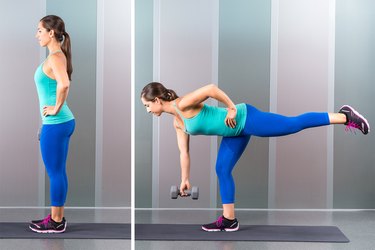
A unilateral version of a traditional stiff-legged deadlift, this move requires a ton of balance and core stability.
- Stand on your right leg while holding a dumbbell at your side in your right hand.
- Keeping the right knee slightly bent, perform a stiff-legged deadlift by bending at the hip, extending your free leg behind you for balance or resting the top of your foot on a bench.
- Continue lowering the dumbbell until your upper body is parallel to the ground, and then return to the upright position.
Reps: 10 to 15 on each side
Targets: glutes, hamstrings and spinal erectors (muscles that support and stabilize the spine)
Single-Leg Hip Pops
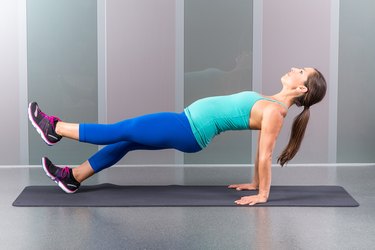
This challenging exercise primarily targets the hamstrings of the supporting leg. "It is a great hamstring exercise both bilaterally and unilaterally, with the additional benefit in the single-legged movement of hip rotators and stabilizers," says Pire.
- Sit on the ground, legs extended in front of you and feet flexed.
- Place your hands on the ground next to your hips with your fingers pointed toward your feet.
- Raise and hold your left leg a few inches off the ground, pushing your right heel in the ground.
- With the arms extended, supporting your weight on your hands, lift your hips as high as possible in a straight-body position (ankle to knee to hip to shoulder).
- Lower your hips back to start, then quickly and explosively pop them back up.
Reps: 10 to 12 on each side
Targets: hamstrings
One-Armed Lateral Raise
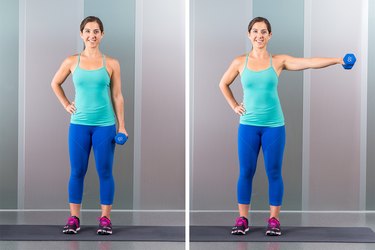
The single-arm version also requires core stability for balance. "Be sure the naturally weaker side does all the work on its own," says Olson. "Over time, you'll soon see and feel a better strength balance between the two sides of your body."
- Stand with feet hip-width apart, holding a dumbbell with a neutral grip (palm facing toward the body).
- Move the dumbbell to the front of your thigh, keeping your elbow slightly bent.
- Raise the dumbbell up and out to the side, elbow and upper arms rising together ahead of the forearm, hand and dumbbell.
- Bring the dumbbell up so that it's nearly level with shoulders.
- Return slowly to the starting position.
Reps: 10 to 15 on each side
Targets: deltoids (shoulders) and trapezius (upper-back)
Read more: The Ultimate Workout for Sexy, Sculpted Arms
Overhead Single-Arm Press
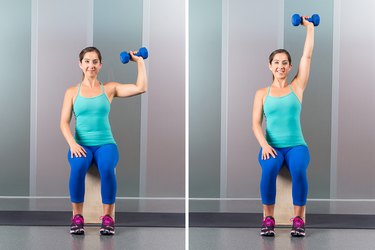
This shoulder move mainly recruits the deltoids and trapezius as well as some triceps. As with any single-arm movement, it requires more core stability than the two-armed version to hold yourself upright.
- Sit or stand with your feet shoulder-width apart, back straight.
- Hold a dumbbell at shoulder level with your arm at a right angle, palm facing forward, thumb pointing toward your ear.
- Bring the dumbbell up over your head by extending your elbow and straightening your arm.
- Slowly return to the starting position.
Reps: 10 to 15 on each side
Targets: deltoids, trapezius and triceps
One-Armed Dumbbell Row

This one-sided back exercise targets the latissimus dorsi, trapezius, rhomboids and forearm flexors, including the biceps muscles. Keep your core engaged throughout the movement to stabilize and support your back.
- Hold a dumbbell with your palm facing the side of your body.
- Place the other hand and knee on a bench and keep your back flat throughout the move.
- Start the movement by lifting the elbow as high as possible next to the body with the elbow bent.
- Maximize contraction by rotating your torso slightly at the end of the row.
Reps: 10 to 15 on each side
Targets: latissimus dorsi, trapezius, rhomboids, forearm flexors and biceps